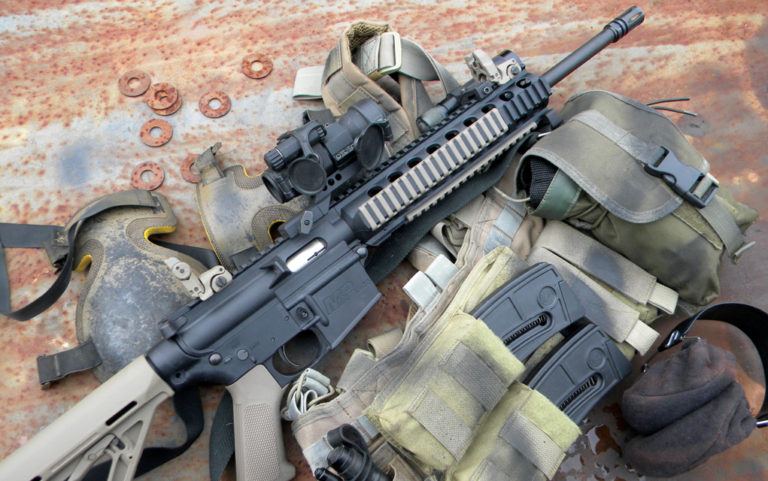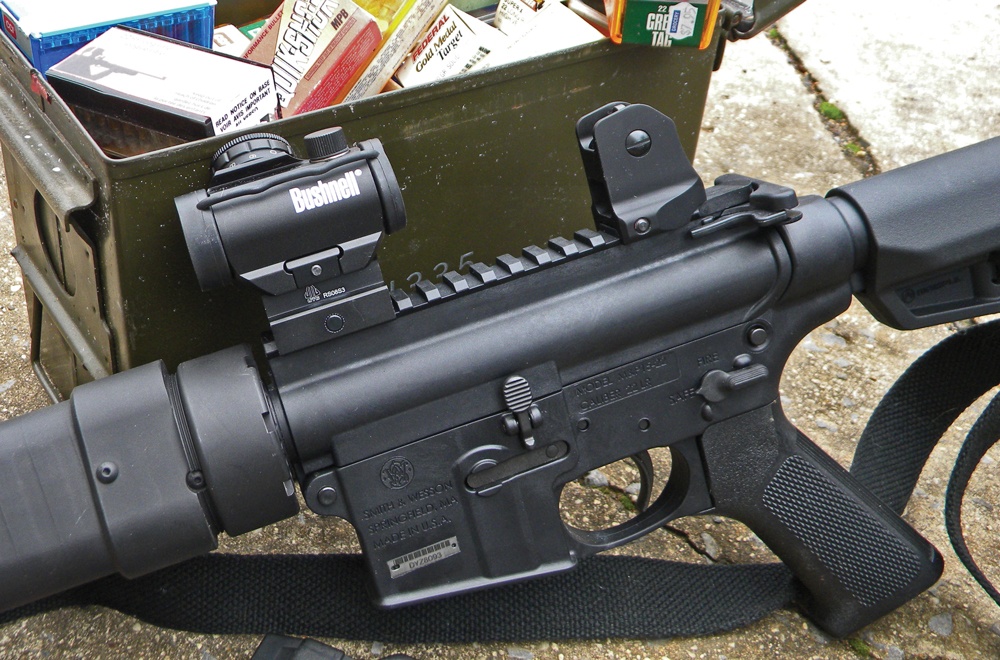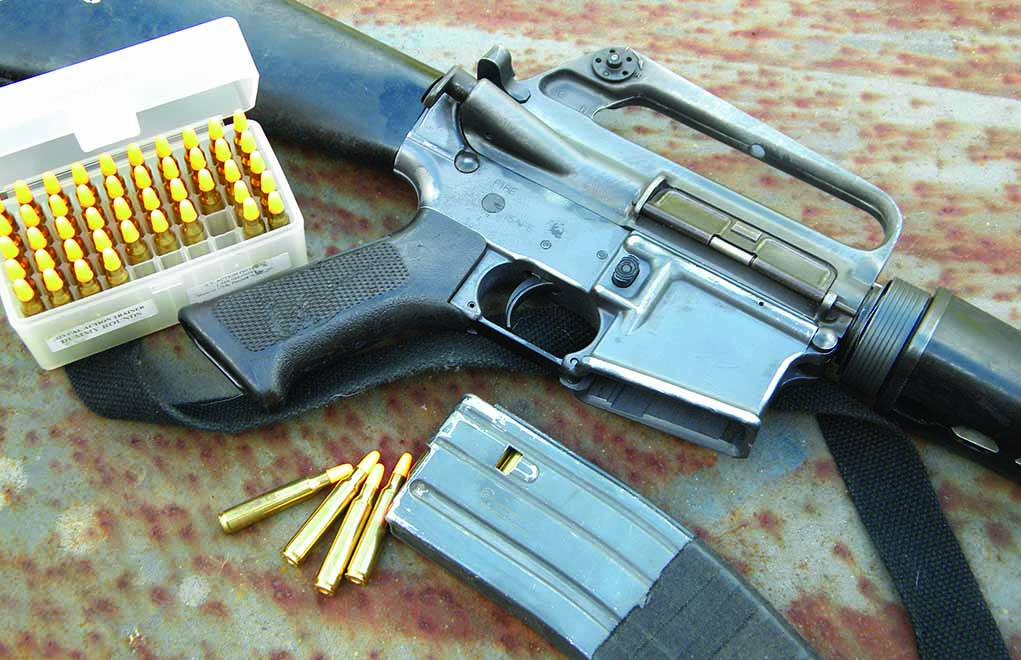
Generations past learned to shoot behind a .22 LR bolt rifle. Today, the .22 LR AR-15 is that perfect learning tool.
How the .22 LR AR-15 is the perfect tool to learn the platform:- It’s reliable caliber, no matter the ammo you run.
- Given its light recoil, it's easy to shoot.
- It is extremely accurate.
- Ammo is very affordable.
- Hands down, its plain fun to shoot.
I was raised on guns. There are pictures of Dad holding a .22-caliber rifle in my shoulder so I can fire it. I can’t remember not shooting, but I do remember is that it all started with a .22 LR single-shot rifle and firing from prone. In those days, you were expected to learn how to shoot a .22 from prone — one accurate shot at a time — before ever progressing to anything else.

And the same is true today. Regardless of age, learning how to shoot begins with the fundamentals. The AR is a lot like a .22 LR many of us grew up on: It’s reliable, easy to use and extremely accurate — it’s an “if I can see it, I can hit it” kind of rifle. It’s the perfect platform to use on your way to becoming a rifleman or woman. But, this journey is about a lot more than just acquiring the gear.
Learning how to use the AR, or any other firearm, starts with the fundamentals of marksmanship: Aim, hold, press and follow-through. The cool thing about the AR is that you can still do this with the .22 caliber, buying a dedicated .22 LR AR — my favorite is the Smith & Wesson M&P 15-22 — or using a conversion kit with a .223 Rem./5.56 NOTA AR. And prone is still the best position to start with.
What You Should Work On With Your .22 LR AR-15
Finding NPOA
You start by learning about natural point of aim, or NPOA. This is a firing position that relies on bone support as opposed to muscle tension. You get into position with the sights on target. Shut your eyes, and inhale and exhale several times. Now, open your eye and note where the sights are. While breathing, your body settles into its “natural” position — you’re not using muscles to hold the sights on target. If the sights shifted left or right of the target, then reposition your entire body instead of muscling the sights back on target.
More AR Articles:
- 7 Affordable 9mm Carbine Options
- Top Options In AR Pistols From Daniel Defense
- Properly Using A Defensive AR-15 From Cover
- Should You Own A Pistol Caliber Carbine?
Using your bone structure to keep the rifle on target is always more consistent than relying on muscle tension, and shooting accurately is always about consistency. You do the same thing — the exact same way over and over until achieving the desired results — which is the ability to place your shots exactly where you want them.
Before ever firing a shot you check, establish and confirm your NPOA. This is true for every firing position — even standing or offhand. Eventually you get to the point where you can line up the target, assume your firing position and you’ll have a solid NPOA. This is the true “aiming” part of marksmanship.

But there’s a lot more to NPOA than getting the first shot to land where you want it: NPOA helps “hold” that position as the shot is fired and in-between multiple shots.
Sight, Breath And Trigger
Your visual hold with iron sights is achieved by focusing on the front sight. If you’re a pistol shooter, you already know this. Our eyes don’t have the ability to focus on the target, the front sight and the rear sight all at the same time. So, you focus on front sight — the middle of these three objects. The target will be blurry, but you can still tell if the front sight is holding where it should be. The rear sight is blurry — a ghost ring sight is perfect for this because your eye naturally wants to center the front sight in its rear ring or aperture — but again you can hold the front sight stead in its center.
Hold also involves breath control. If you’re breathing while pressing the trigger, the front sight and muzzle will be moving, which is going to cause vertical separation in your shots. You have to stop breathing to hold the sights steady, and the best place to stop breathing is after you exhale. Empty lungs are always more consistent than “half” full, which will vary according to physical stress. Plus, there’s a natural pause that occurs between exhaling and when you start to inhale. You’re just trying to extend that natural pause out a little longer than normal in order to press the trigger.
Pressing the trigger smoothly is mandatory for shooting accurately as well. Think about it this way: Your job is to hold the sights on target and smoothly press the trigger. It’s up to the rifle to decide when to fire the shot. When the shot does break, it should be what Jeff Cooper called a “surprise” break. Otherwise, you’ll anticipate the shot, muscling in behind the rifle in anticipation of the recoil that’s coming – and this will throw your accuracy way off. Hold it steady, pressssssss the trigger and let the rifle fire the shot.

Once the shot fires, you follow through … which consists of recovering from the recoil, reacquiring the sight picture and resetting the trigger. This sequence ensures you don’t disturb the harmonics of the rifle, which will affect your accuracy. You concentrate on recovering from the recoil as opposed to attempting to control it. You’re focusing on the front sight before, during and after the shot, and then returning it to the target.
Trigger reset, of course, means keeping it pressed to the rear and then — once the sights are back on target — you release the trigger, but only far enough until you feel the internals of the AR “click,” which means the disconnector has released the hammer so the trigger is holding it back. If you let your finger fly off the trigger after the shot, it will certainly affect accuracy … and not in a good way. Plus, follow through prepares you to shoot again if necessary.
Today’s Best Learning Tool
Eventually, you start working with other positions, such as sitting and variations of kneeling, and learning how to manipulate the AR — loading, unloading and reloading, and clearing malfunctions. Again, the AR is a great platform for this. All its controls are in exactly the right place for both right- and left-hand shooters.
A rifleman should also know how to maintain an AR. Keeping it clean and lubricated ensures a lifetime of service. It’s usually a simple task to replace a broken or worn part, which doesn’t happen often.
At some point, you start to develop an understanding of ballistics and trajectory. You learn what’s necessary to make a shot at distances multiple-hundreds of yards and beyond.
Rifle work is like a religion, with a little “r.” You have to practice it regularly … otherwise it does you no good. You study and research. It’s something you never master; you’re always striving to improve. The AR is a great firearm to take this satisfying and rewarding journey with.
Editor's Note: This article originally appeared in the February 2018 issue of Gun Digest the Magazine.

Next Step: Get your FREE Printable Target Pack
Enhance your shooting precision with our 62 MOA Targets, perfect for rifles and handguns. Crafted in collaboration with Storm Tactical for accuracy and versatility.
Subscribe to the Gun Digest email newsletter and get your downloadable target pack sent straight to your inbox. Stay updated with the latest firearms info in the industry.

![Best Concealed Carry Guns In 2025 [Field Tested] Wilson Combat EDC X9S 1](https://gundigest.com/wp-content/uploads/Wilson-Combat-EDC-X9S-1-324x160.jpg)


![Best 9mm Carbine: Affordable PCCs [Tested] Ruger Carbine Shooting](https://gundigest.com/wp-content/uploads/Ruger-Carbine-Shooting-100x70.jpg)
![Best AR-15: Top Options Available Today [Field Tested] Harrington and Richardson PSA XM177E2 feature](https://gundigest.com/wp-content/uploads/Harrington-and-Richardson-PSA-XM177E2-feature-100x70.jpg)
